Entries by Hifliercanada (97)
A Great Personal Resource
Hannelore Headley is a remarkable woman. At age 21 she became Canada's youngest independent book seller in Vancouver BC shortly after arriving from Shanghai with her family. Hannelore spent her youth in China after fleeing Nazi Germany with her parents in advance of the horrors about to be inflicted on Europe during the late 1930's and early 1940's.
Her family left Berlin in 1939 to find refuge in Shanghai. She was barely three years old at the time. Hannelore spent fourteen years there and learned much about the world as a young lady. During her family's stay in Shanghai she mastered the craft of book dealing from her late father and later would established her own business using the many skills he shared with her.
Later, as a grown woman, Hannelore moved to St. Catharines, ON where she raised a family and continued to work in the book trade. She operates two truly fine book stores which are filled with fine old volumes that Hanna personally selects from the myriads of titles brought to her by people cleaning out book shelves. Hannelore's knowledge of books is immense and she has an Honorary Doctorate which signifies her many accomplishments in the world of book selling.
Recently, she published a memoir of her early life. Entitled Blond China Doll - A Shanghai Interlude: 1939-1953, the book is a wonderful story and marvelous read. Set against the backdrop of turbulent times, Hannelore places personal scale onto the difficult and horrific era from the late 1930's through to the early fifties.
I first met Hannelore in 1992 when I began to earnestly acquire books on the topic of kites and the history of early aviation. After several visits to her shop on Queen Street in St. Catharines we engaged in longer conversations and she discovered the source of my quest. She suggested that she and her staff would look for items that came into her collection on the topic of kites and keep them aside for me.
Our friendship has grown over the past fourteen years and it is always a treat to visit with her in her store. I am not sure who is more excited when a "kite book treasure" has turned up. From children's books, to kite illustrations or photos in a book that has little to do with kiting in general, to full fledged works on kites and kite pioneers, Hannelore has steadfastly sought out items for my research library.
Just yesterday I made one of my periodic stops at her store. Although she did not have any treasured items for me, her warm greeting and our conversation lifted my day and enriched me with her genuine interest in how I am doing.
I truly appreciate Hannelore's friendship, her keen eye and her sharp memory in keeping watch for resources to build my kite library! She has such amazing knowledge about books, authors, history of the world and so many topics that she is awe inspiring.
Best Breezes - A Kiter's Journal
Welcome to my 'new' Kiter's Journal. A previous series of journal entries was hosted on another site. I have chosen to move my journal/blog to Squarespace because of the elegant features it contains and the ability to have my blog and my web site linked in one location.
This journal is the place where I will share my thoughts and records of my kiting activities with anyone interested in following the ramblings of my mind. Occasionally I will make entries of general items and thoughts that intrigue or perplex me.
Kites are a passion with me. For over fifty years I have been fascinated with tethered flight and the wonderful devices called kites that are attached to the end of my kite line or, on occasion, staked out in the ground near me.
I hope that you will find my entries interesting and engaging. I welcome your thoughts and email questions about any of the items on this site and in this journal.
Note: Journal entries dated before September 2005 have been imported here from my previous blog space.
Sincerely, Bob White ("HiflierCanada" )
Filming the Flight of the Bell Tetrahedral Kite for CBC-TV
Filming the Flight of the Bell Tetrahedral Kite for CBC-TV
Alexander Graham Bell - "The Greatest Canadian!"
As part of the TV documentary series "The Greatest Canadian", CBC-TV required a Bell tetrahedral kite as a visual prop to explain some of Alexander Graham Bell's work in early aviation.
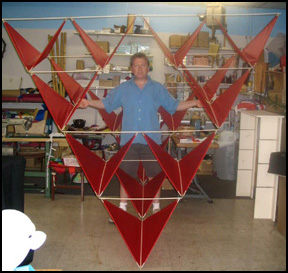 A 16 cell tetrahedral kite was built by Morris Canning of Parrsboro, NS (shown left) to be used in the segment about Bell's kites. The remainder of the story of Bell's use of kites is revealed through the use of archival photos from the A.G. Bell Museum in Baddeck, NS.
A 16 cell tetrahedral kite was built by Morris Canning of Parrsboro, NS (shown left) to be used in the segment about Bell's kites. The remainder of the story of Bell's use of kites is revealed through the use of archival photos from the A.G. Bell Museum in Baddeck, NS.
I was contacted in late July of 2004 by Patti-Ann Finlay, a CBC researcher assigned to the project, to discuss the role of tetrahedral kites and possibly build one for the documentary. My commitments to our local kite festival prevented me from actually building the kite. So Morris Canning undertook the construction of the kite and shipped it to me for my work with the CBC documentary crew. It was my task to assemble it, test fly it, teach CBC on-air staff to fly the kite and manage its use within the documentary.
The opportunity to work on a project like this would be exciting to any kiter and I eagerly entered into the project. Patti-Ann and I consulted on the phone on a number of occasions.
 The kite that Morris built arrived on September 24th. It is an elegantly constructed kite and Morris clearly is a very fine kite builder. The complicated corner connections on the kite are nicely made out of vinyl tubing. They are surprisingly effective at giving the kite structural integrity at the complicated joints of tetra cells. The spars are of 3/16" hardwood dowel which make them light, yet reasonably strong. The sails are of red ripstop and they are very nicely sewn. Red was chosen to emulate the red silk used by Bell in his tetrahedral kite experiments at Beinn Bhreagh in Baddeck, N.S.
The kite that Morris built arrived on September 24th. It is an elegantly constructed kite and Morris clearly is a very fine kite builder. The complicated corner connections on the kite are nicely made out of vinyl tubing. They are surprisingly effective at giving the kite structural integrity at the complicated joints of tetra cells. The spars are of 3/16" hardwood dowel which make them light, yet reasonably strong. The sails are of red ripstop and they are very nicely sewn. Red was chosen to emulate the red silk used by Bell in his tetrahedral kite experiments at Beinn Bhreagh in Baddeck, N.S.
The date of filming was set for Thursday, September 30, 2004 at Milliken Park in the borough of Scarborough, city of Toronto. Upon my arrival at 11:00 a.m., I set up two perimeter wind ribbons on twenty foot telescoping poles to help us determine wind direction and speed during the takes for the flight sequence. Winds were light and intermittent. However, when there was a bit of wind it seemed that we would be able to carry out the flights according to plan.
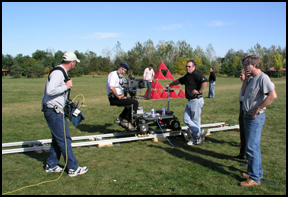 I completed the assembly of the kite and staked it to the ground to avoid an unwanted lift off. The setup of the film equipment was undertaken by CBC's technicians. It was at that moment that I realized the complexity of the task. The camera crew required a ninety foot track to be set up for their camera sled to ensure smooth filming as they provided motion and panning to the shots. Immediately I worried about the variability of wind direction. It was no easy task to set up the track, camera and sound equipment and if the wind did not hold in the general direction of the established layout we would be in serious trouble.
I completed the assembly of the kite and staked it to the ground to avoid an unwanted lift off. The setup of the film equipment was undertaken by CBC's technicians. It was at that moment that I realized the complexity of the task. The camera crew required a ninety foot track to be set up for their camera sled to ensure smooth filming as they provided motion and panning to the shots. Immediately I worried about the variability of wind direction. It was no easy task to set up the track, camera and sound equipment and if the wind did not hold in the general direction of the established layout we would be in serious trouble.
Ask any kite flyer about constant wind direction and they will tell you that there are no guarantees. There may be prevailing winds and there may be on-shore/off-shore wind conditions that are typical, but there are no guarantees on constancy of wind direction for any one day or period in a day. I was quietly worried.
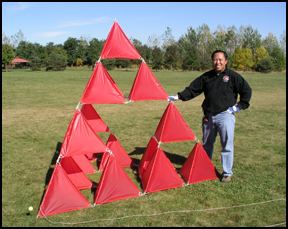 At about 12:30 p.m. my good friend Gary Mark of TKF arrived to take some photos of the event as well as to lend some encouragement and support. It was not long before Gary was an active and involved member of the kite crew and a highly valuable additional resource consultant. We decided that a test flight would be useful since I had only flown the kite in a four cell configuration to check some basic flight characteristics. I had never actually handled Morris' tetrahedral in its full sixteen cell configuration.
At about 12:30 p.m. my good friend Gary Mark of TKF arrived to take some photos of the event as well as to lend some encouragement and support. It was not long before Gary was an active and involved member of the kite crew and a highly valuable additional resource consultant. We decided that a test flight would be useful since I had only flown the kite in a four cell configuration to check some basic flight characteristics. I had never actually handled Morris' tetrahedral in its full sixteen cell configuration.
We walked the kite out for a very long launch due to the light wind conditions. So far so good - the wind direction remained aligned with the camera track location.
A tug, a few backward steps after Gary hand launched the kite and the kite was airborne. The kite climbed quickly and steadily and lofted into a stable position. Spontaneously the crew, director and management team broke into applause. The kite hung there for a few seconds and then the breeze died and I reeled in as quickly as possible to keep tension on the kite and bring it in for a soft landing. Gary broke into a sprint to soften the impact of the kite on the ground. He demonstrated good speed and agility and assisted the landing nicely.
Morris Canning constructed the kite lightly, but well. His intention, I figured, was to ensure good balance and provide a light enough framing structure to ensure easy flight in lighter winds. That was a good decision for we did not have strong winds during the day. Generally top wind speed, when the wind was up, was estimated at about 10-12 km per hour. Fequently it was much lighter than that and flying the kite required some vigorous pulling in of line to maintain elevation for the brief ninety second vidoe sequence .
Morris likely did not realize that we would have to accomplish about 15 flights during the day to ensure a good take for use in the documentary. All of the flights required some skilled line handling on the bridle and frame for launch. In addition delicate landings were necessary when the winds failed.
To ensure that the kite frame would not break we raced out to grab the kite and prevent it from dashing into the ground on each occasion. Gary Mark demonstrated 'great wheels' and proved that he is considerably younger and fitter than I am. Gary was assisted by Patti-Ann Finlay and Andre Czernohorsky of CBC. Great 'saves' were made on a number of occasions. However, there were a few crunches resulting in some broken spars. In addition, launching the kite seemed to put a good deal of strain on the frame and a few spars were broken at the start of some of the flights.
Each break required some disassembly of the kite to get at the cell that suffered the damage. Spar repairs were made, reassembly accomplished and subsequent "takes" were set up. As everyone knows, the Director wants to have several choices on tape from which to make a final selection.
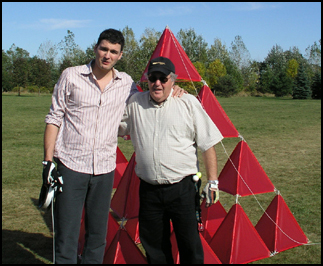 In all, we did ten takes of on-screen narrator Evan Soloman of CBC Newsworld explaining the features of the tetrahedral kite, Bell's reasons for choosing the tetrahedral structure, and a demonstration flight. The kite performed well each time.
In all, we did ten takes of on-screen narrator Evan Soloman of CBC Newsworld explaining the features of the tetrahedral kite, Bell's reasons for choosing the tetrahedral structure, and a demonstration flight. The kite performed well each time.
At the end of shooting the sequence with dialogue we readied the kite for one final flight with Evan not doing any narration. The purpose for the final flight was to get some unusual camera angles of the kite and Evan as the kite flyer. It was thought that these flight sequences might be used when the credits are shown for the documentary.
Following a long flight sequence the camera crew were satisfied and, on cue, the light winds died and the kite dropped. This time a few broken spars ensured that I would have some work at home to put it back in pristine condition. However, it had done it's job and Morris' fine version of the tetrahedral more than stood up to the rigorous multi-flight test.
The sequence will be part of the Bell documentary to air on November 15, 2004. For more information on "The Greatest Canadian" series, visit the CBC site dedicated to the project. Within the overall site on the series is a section devoted to Alexander Graham Bell.
My appreciation is extended to Patty-Ann Finlay of CBC-TV for including me in the work on this project. My hat is off to Morris Canning for his kite building skills and my good friend Gary Mark of Oakville, ON for helping out with his fine flying skills. Thanks also to host Evan Soloman and the entire crew for making Gary and I feel so special and involved. It was truly an interesting day of kiting!
Kite Buggiers Conquer Gobi Desert
Kite traction equipment and skills have come a long way since Peter Lynn of New Zealand helped to pioneer kite buggies in the 1990's . I just caught this report in today's news and thought I would share it here with folks who have not been able to read it.
Kite Squad Conquers the Gobi Desert
by Sarah Park
A 61-YEAR-OLD adventurer has set a world record by crossing one of the world's harshest regions by kite. Extreme sport fanatic Brian Cunningham, who is visiting professor at Manchester University and comes from Heaton in Bolton, completed the first kite-powered crossing of the Gobi Desert in Mongolia. Making up his team were his wife, Christine, and two other dedicated extreme sports fanatics. Prof Cunningham's daughter, Carole, 21, a student at Salford University, said she was proud of her father who has dedicated himself to the gruelling challenge. She is looking forward to her parents finally coming home.

Prof Cunningham, Christine, and Kieron Bradley and Peter Ash, both from Norwich, spent 17 days being pulled through the desert by wind power with the use of specially adapted Parastorm Kite-buggies. In temperatures of more than 100 degrees during the day and below freezing at night the foursome traversed more than 1,000 kilometres through thorn bushes and rocky ground. Speaking via satellite phone, Prof Cunningham said the terrain had proved far worse than expected and had challenged the team to the limit. "If we had known before we left how unforgiving the landscape is, we might have questioned the feasibility of the route we had chosen," he said. Two years ago he made a successful 650-mile trip at the South Pole powered by the revolutionary kite buggy.
Note: this article has been re-published here fron an earlier blog that I had on the excellent Blogger service. Since I am trying to consolidate all my writing in one location, I have moved it here in its original form and with the original date of publication.
Kites in the Movie: Finding Neverland
Sometimes kites are used in movies as a prop to help set the theme and the era of the film. Occasionally a kite is a major prop. For example, I loved the Cody-type kite that was used to provide rapid propulsion assistance in Kevin Costner's WaterWorld. It was one of the most dramatic uses of a kite in a movie that I have ever seen.
Now there is a new movie about to be released (October 22, 2004) which will feature a kite that is historically correct for the period setting of the movie. In the new movie Finding Neverland, Director Marc Forster (Monster's Ball) uses a kite to help detail a setting between the principal actors Johnny Depp and Kate Winslet.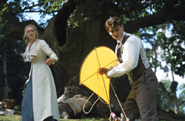
Finding Neverland is a tale of magic and fantasy inspired by the life of James Barrie, the real-life author of the children's classic Peter Pan. Set in London in 1904, the film follows Barrie's creative journey to bring Peter Pan to life, from his first inspiration for the story up until the play's premiere at the Duke of York Theatre - a night that will change not only Barrie's life, but also the lives of everyone close to him.
Detailed information on James Barrie, his life and the famous Peter Pan story and play can be found in Petri Liukkonen's great web site on famous authors.
The kite used in the brief pastoral scene in the movie is an English Arch Top kite. Likely it is made of modern day nylon and not the materials of the day. From the photo it is difficult to ascertain the materials used in the framing of the kite.
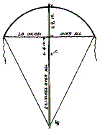 The English arch top kite is a modification of the more primitive two-stick lite. It is usually made like the two-stick kite with the addition of an arched top made of a curved framing strip of rattan or bamboo. The line drawing of the "English Arch Top Kite" that follows shows its structure.
The English arch top kite is a modification of the more primitive two-stick lite. It is usually made like the two-stick kite with the addition of an arched top made of a curved framing strip of rattan or bamboo. The line drawing of the "English Arch Top Kite" that follows shows its structure.
It appears that the kite in the movie foregoes the tassels on the cross spar but it does feature a tail for stability. In addition, the kite in the movie does not seem to be of the same dimensional proportions as a typical arch top kite. It appears that:
- the section of the kite above the cross spar appears to be taller and the more of a curve is used than in an original design
- the length of the kite below the cross spar is somewhat shorter. However, the angleat which the kite is being held in the photo could account for the appearance of differences in dimension.
Although I am looking forward to seeing the movie because of the story of Barrie's life (it is fascinating), the added pleasures of two optical delights: a yellow arch top kite -and- Kate Winslet will also draw me to the box office!




